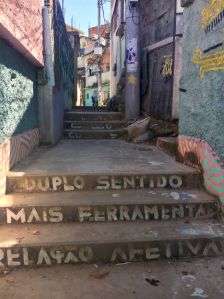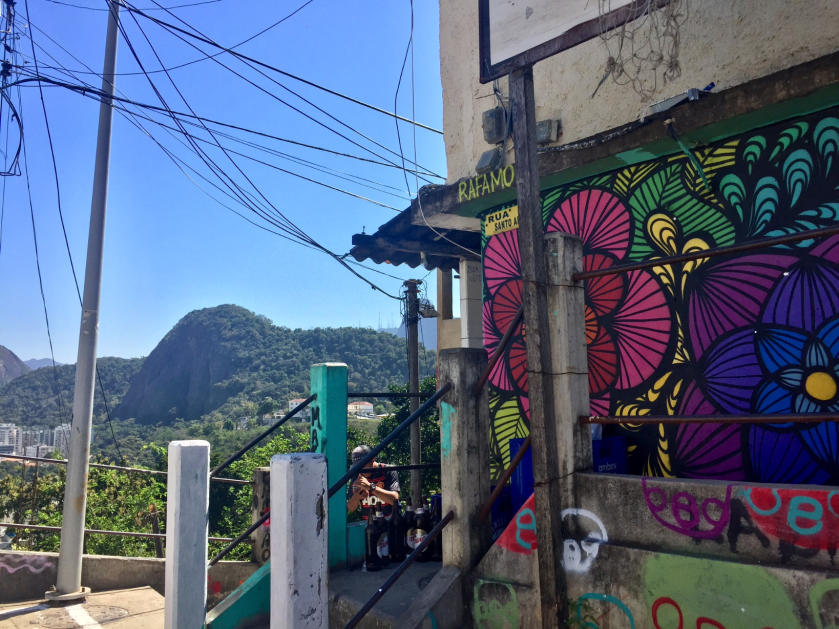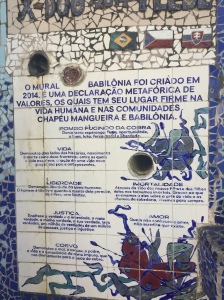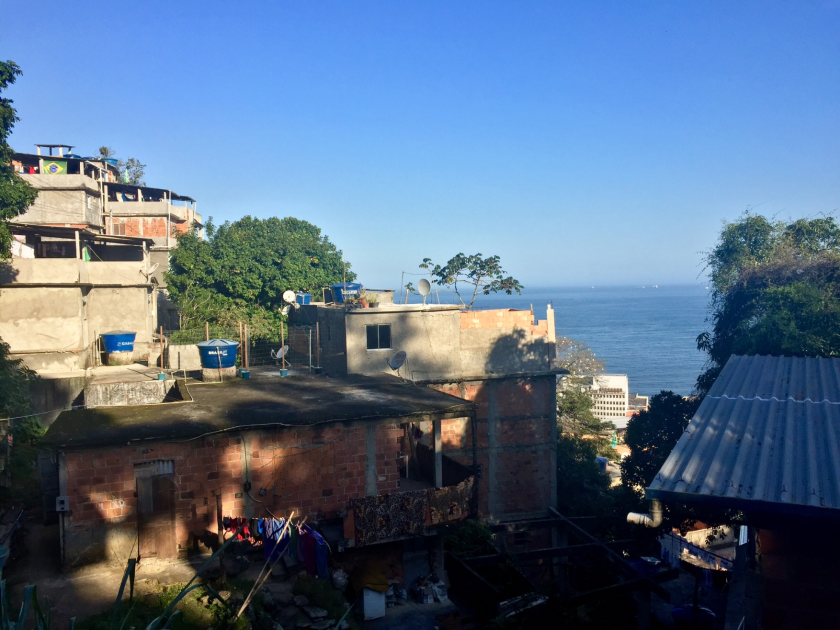I’m sitting on the balcony of our hostel as my travel companion Florian takes a nap. The view to my left is the famous Copacabana Beach, dotted with sunbathers. To my right, the statue of Christ the Redeemer looks over the south zone of Rio de Janeiro. The sound of someone cleaning dishes floats out of a neighbour’s window, and two dogs are barking at each other not too far away. It’s a hot day, 32 degrees Celsius at 2:00 in the afternoon, so the fan in our room is on full blast. If you were to look at our location on Google Maps, it might look as if we are staying in the wealthy Rio neighbourhood of Leme, known for its wide tree-lined streets and modern beachfront condominiums. However, we are not in a condo overlooking the ocean. We are staying on a hill just behind Leme in Favela Babilônia. It is one of the hundreds of makeshift neighbourhoods that are home to around 1 in 5 of Rio’s inhabitants, and it sheds a light on both the resourcefulness and hardships that can be found in Brazil’s most iconic city.

A number of the surprising things have stuck with me after staying in one of Rio’s favelas. I wouldn’t claim that my experiences apply to every favela in the city, or even that they paint a complete picture of Favela Babilônia. After all, Florian and I stayed there for only three days, and saw it through the eyes of two tourists who do not live, work or have family in the city. There are poorer and richer favelas in Rio, and more dangerous and safer ones as well. However, after seeing depictions of favelas for years in movies, TV shows, books and videogames, my three days in Babilônia challenged the preconceptions I had about life in Brazil’s poorest areas and the people who live in them.
While Favela Babilônia is mere steps away from Rio’s world famous beaches, it might as well be located in a different world. Unlike the majority of the South American cities I have visited this year, where poor areas and rich areas are distinctly separated within city layouts, Rio is unique in its hectic jumble of favelas and rich neighbourhoods. In Santiago, the wealthy east side slowly and gradually transitions into poorer neighbourhoods as you travel west, north and south. In Rio, a 30-minute walk can take you past a mosaic of tourism, underdevelopment and vast wealth, all living side by side. Without turning this into a history lesson, the principal reason the favelas were built all over the city had to do with slavery. While many North Americans tend to think of the U.S. South as the hotbed of slave activity following the discovery of the New World, Brazil was actually home to 11 times more slaves than the U.S, with a huge majority of them living in Rio. When slavery “ended” in the late 1800’s (Afro-Brazilians were still denied many basic civil rights and liberties post-slavery), many former slaves suddenly found themselves with no income, homes or job opportunities. They started building these favelas into the hills of Rio without any government oversight or assistance since they had no other options for shelter, and very limited resources. Soon these neighbourhoods became some of the most iconic images of Rio, and their growth was further driven by mass-migration into Rio from rural Brazil. Today, the favelas are everywhere in Rio, growing on the sides of the city’s many hills, and stretching from the photo-famous south zone to the farthest outskirts of the city.

Violence is a persistent factor of life in many favelas. Babilônia, for example, is contested by two armed gangs (our host considered the local police branch to be the third). There are infrequent skirmishes at the border separating their two sides. However, Babilônia is a relatively ‘pacified’ favela, and we stayed there during a lasting ceasefire that had been in effect for several months prior to our arrival. As such, we were fortunate not to see any conflict during our stay. However, our host did take us for a tour of the area, and pointed out bullet holes in some walls from several years back when the violence had been much worse. And even though our hostel was located far from the border, on several occasions we saw younger gang members (I would guess 14 or 15 years old) watching the entrance to their territory, often with handguns not-so-subtly concealed beneath their basketball shorts. As foreigners, we were “protected” by some of the unwritten rules of the favela, namely that visitors are to be left alone at all times. Residents, whether they are associated with the gangs or not, want more foreigners to visit the favela. The goal is to bring attention to the realities of life in their community. Government investment in favelas in almost non-existent, with most money going towards minor, short-term “facelifts” whenever international attention focuses on the city (such as during the World Cup and 2016 Olympics). So locals do what they can to bring outsiders to Babilônia, and one aspect of this is that visitors like us are to remain untouched. We even received smiles and bom dia’s from residents when we walked around. Most favelas are not nearly as safe for visitors, but the combination of the ceasefire and Babilônia’s eagerness to attract visitors meant that Florian and I were relatively safe for the time we spent there.

The most striking thing I noticed was the creativity and improvisation in the favela. All of the available utilities, such as running water and electricity, were provided and managed by the residents. There were corner stores, a community garden, a small church, a school and even a concrete soccer surface. Obviously, the quality of these community assets was not at the same level that we are accustomed to in most parts of Canada. But the creativity in developing and maintaining them was incredible. The restaurant attached to our hostel, managed by our hosts, is so good that it is often ranked amongst the most popular in Rio (look up “Estrelas Da Babilônia” on TripAdvisor, I’m not making this up). It was built entirely by our hosts with the help of other favela residents, by using creative and makeshift solutions to make things work, like the plastic water bottles used as rainproof outdoor lights. The residents of Babilônia demonstrate what is known as jeitinho (Portuguese for “little way”), a word used in Brazil to reference creativity and inventiveness in the wake of limited resources. And amazingly: things worked. We had running water, wifi and electricity for our whole stay. The business owners were more than happy to sell us delicious pão de queijo, brigadeiros and açai that they prepared every day. Above all, there was an attitude that if you wanted something done, you would just do it. No waiting for a permit, no conforming to guidelines about what was an “acceptable” way to build or construct something, just a drive to make things work. Though it may have come from a place of hardship, there was charm and vigour to the way that residents of the favela took it upon themselves to find ways to build up their community, ingeniously using anything they could find.
The last thing that struck me was the people, and the way they went about their day-to-day lives. In the mornings, we would see parents walking their children to schools, people commuting to work, and shop owners setting up. During the day, moto-taxis shuttled residents up and down the hill connecting the favela to Leme, children played soccer and basketball in the streets, people chatted on cell phones as they carried their groceries home. The sun went down, and the sound of music, cooking, laughter and discussion would float through the air. Though the context that underpinned these routines was starkly different than what I was accustomed to in Canada (and even in Chile), the routines themselves were actually quite familiar. Yes, people were walking their children to school on barely paved streets. Yes, the soccer balls were in rougher shape. And perhaps the evening sounds travelled more easily due to the fact that the houses of Babilônia are built more or less on top of each other. But even within the context of economic hardship, a lack of government support, and occasional violence, the people of the favela spend most of their days being people. Despite the widely held perception that favelas are rife with constant violence, residents of Babilônia lived relatively peaceful lives, going about day-to-day routines in ways to which most of us can relate.

My three days in a favela were some of the most interesting and exciting that I have spent so far on exchange. Before spending time in Babilônia, my understanding of how people lived in favelas was quite abstract, informed only through media and stories that I had heard. I certainly can’t pretend to be an expert after only three days, but I believe that I have gained a more nuanced understanding of how people can live their lives in a way that is both adverse and familiar to me as a Canadian. Favela Babilônia is burdened with many hardships, but it is also a community of resourcefulness and aspiration, and I hope to visit it again if I ever get a chance to return to Rio.
Chau meus amigos!


One thought on “Three Days in a Favela”